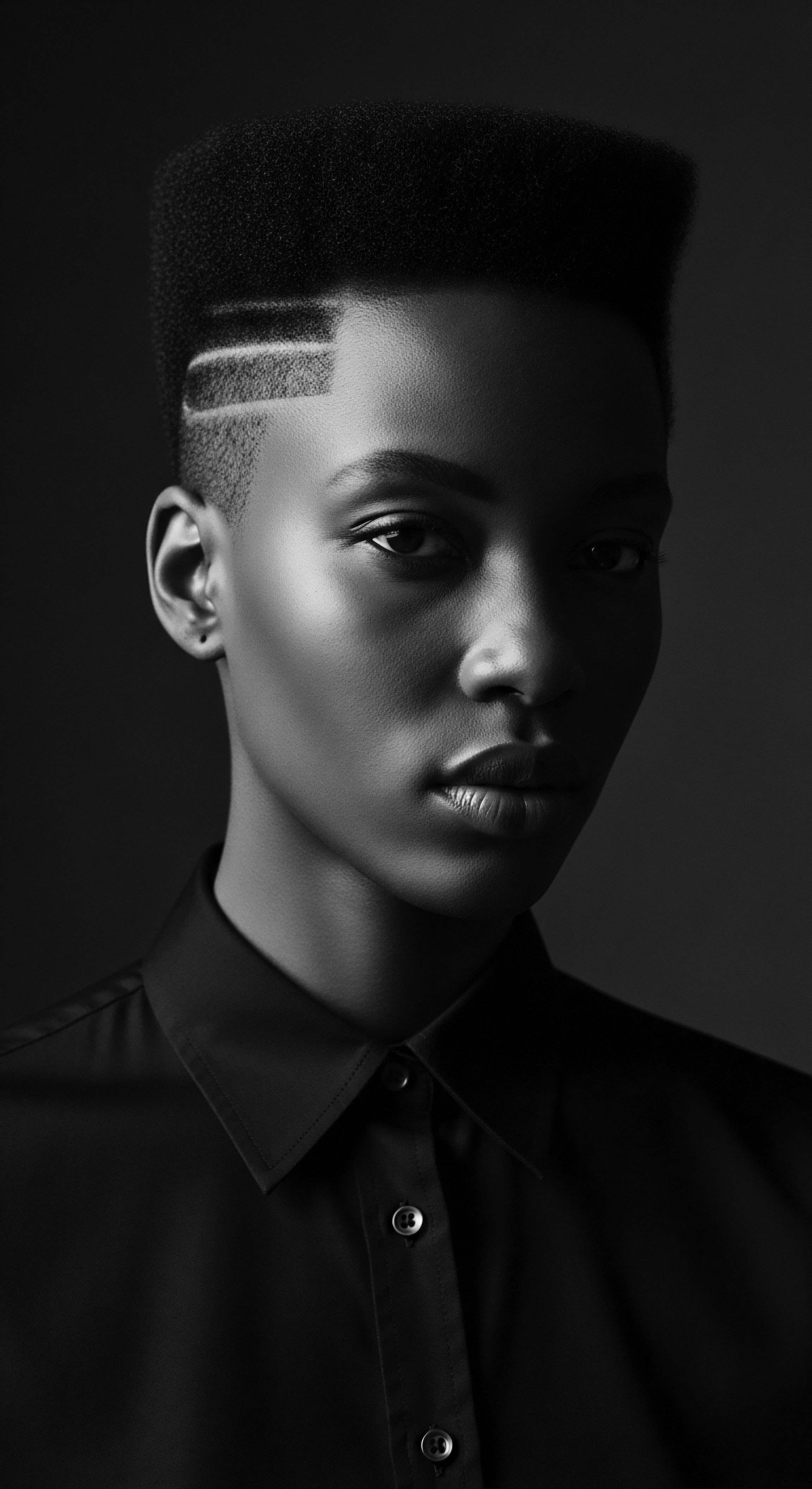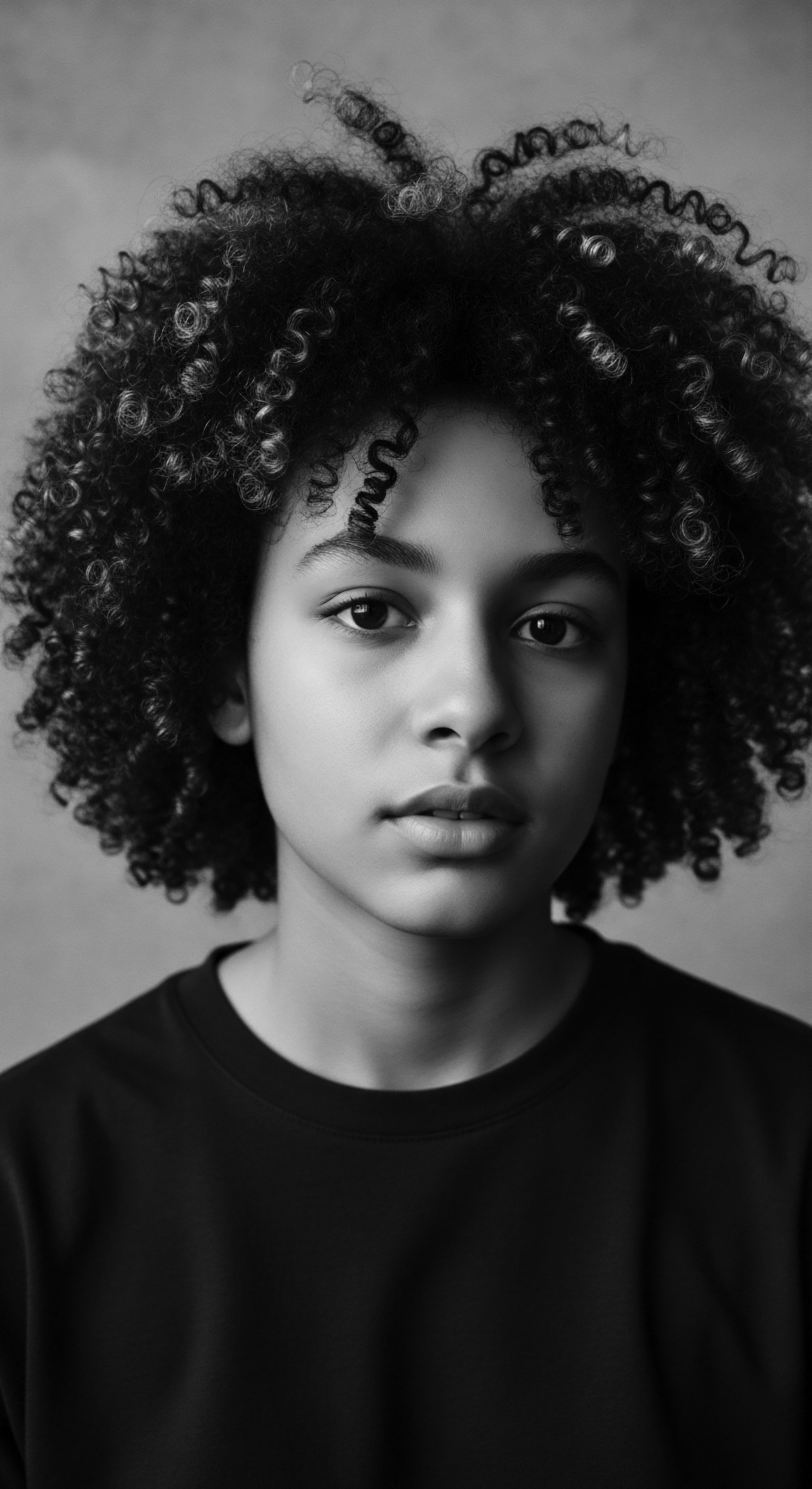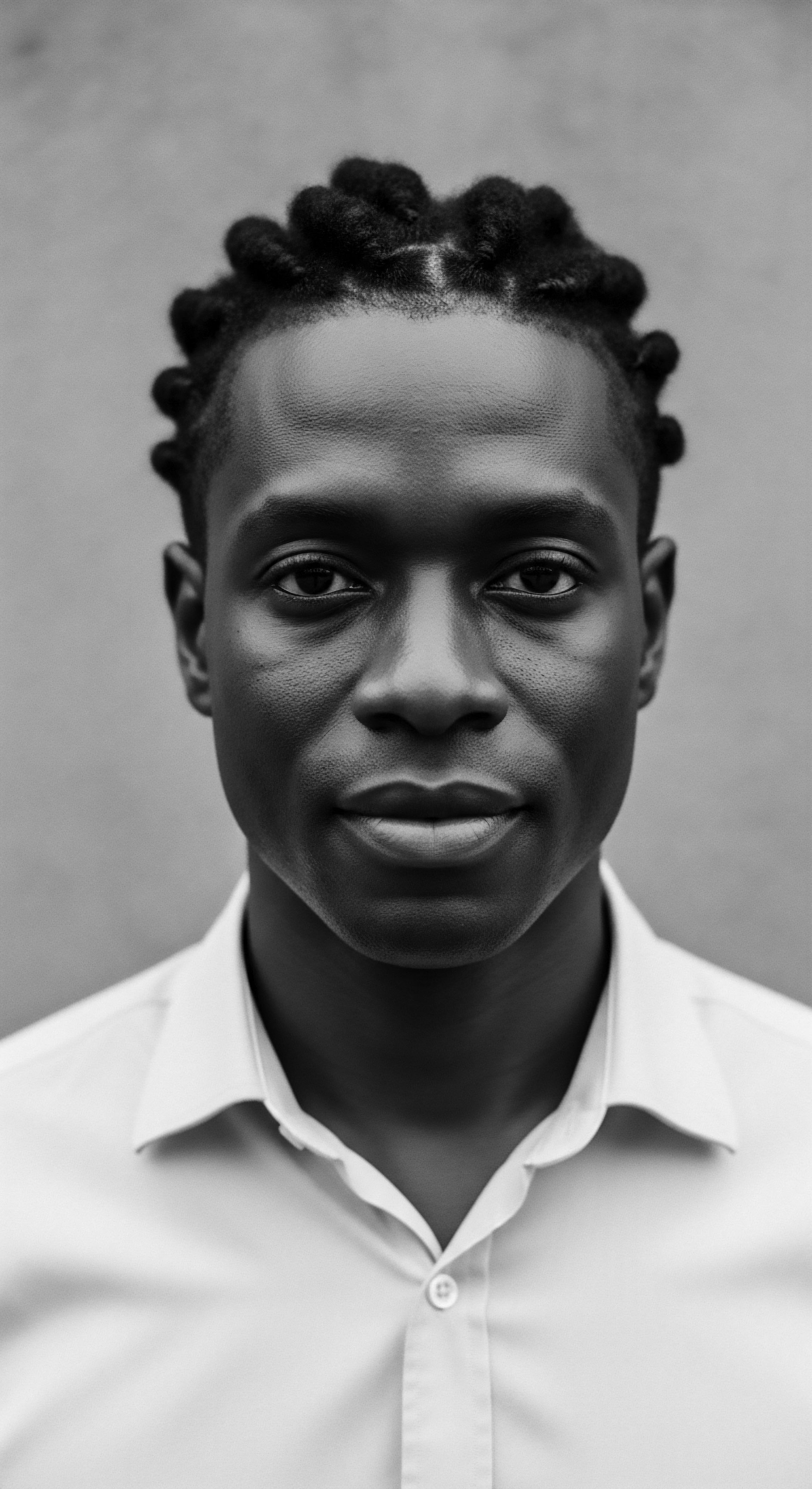
Roots
Consider for a moment the very coil of a strand, the intricate twist that defines its very existence. For those of us whose hair carries the ancestral memory of coils and kinks, this isn’t merely a biological quirk; it is a profound echo of heritage. Each bend, each curve, speaks of resilience, adaptation, and beauty that has journeyed across continents and generations.
Our hair, in its natural state, serves as a living archive, holding wisdom passed down through countless hands, a silent testament to the ingenuity of our forebears. It beckons us to look closer, to feel the whispers of ancient hands applying plant oils, drawing us into a deeper understanding of our own connection to the earth and the stories etched into our very being.
The structure of coiled hair, often flattened or elliptical in cross-section, contributes to its distinctive attributes, including a propensity for dryness. The spiral shape, while granting its unique aesthetic, can hinder the natural flow of sebum, the scalp’s inherent moisturizing oil, along the length of the hair fiber. This inherent characteristic, a scientific reality, forms the very basis for the deep-seated ancestral recognition of how specific plant oils became indispensable. These oils were not simply conditioners; they were, in their true sense, liquid legacy , a bridge between human need and Earth’s bounty.

Understanding Hair’s Ancestral Geometry
Hair anatomy, particularly for those with textured hair, presents a complex marvel. Unlike straight or wavy hair, which may have a more circular cross-section, coiled strands display a greater degree of ellipticity. This distinct shape, coupled with the way keratin proteins assemble, creates the tight spirals that define its curl pattern. This structure provides a natural barrier against the sun in hot climates.
Yet, this very design, while protective in some ways, also introduces specific needs for care. The natural oils of the scalp, produced at the follicle, encounter more difficulty traveling down a curvilinear path compared to a straight one, leading to hair shafts that often yearn for additional moisture and protection.
Historically, this understanding, though not articulated in modern scientific terms, was deeply intuitive. Our ancestors observed the behavior of their hair, its tendencies, its needs, and responded with what their environment provided. The plants around them offered solutions, yielding oils and butters that mimicked or supplemented the scalp’s own offerings. This deep, experiential knowledge formed the bedrock of hair care practices that saw hydration not as a luxury but as a fundamental sustaining act .
The anatomical intricacies of coiled hair illuminate why ancestral peoples turned to plant oils for their essential care.

Pre-Colonial Hair Care Philosophies
In pre-colonial Africa, hair was far more than an aesthetic adornment; it served as a powerful medium for communication, a living canvas for social status, marital standing, age, and even spiritual beliefs. Hairstyles carried significant meaning, often indicating tribal affiliation, wealth, or rank within a community. The rituals surrounding hair care were communal events, fostering social bonds as mothers, daughters, and friends gathered for hours, even days, to wash, comb, oil, braid, or twist hair. This collective tending reinforced social cohesion and transmitted cultural understanding across generations.
The importance of maintaining clean, neat hair, often braided, reflected a societal value, symbolizing the ability to provide for family and land. To have “undone” hair could signify distress or a lack of self-care in some Nigerian communities. This profound connection between hair, personal well-being, and community identity made the deliberate application of nourishing substances like plant oils a sacred, everyday practice. It was a practice imbued with spiritual significance, as among the Yoruba, hair was considered the body’s most elevated part, with braided styles sometimes used to convey messages to divine forces.
The selection of oils was thus not arbitrary; it was guided by observations of their effects on hair health and by cultural significance. These ancestral insights, honed over millennia, continue to resonate in contemporary textured hair care, demonstrating a profound continuity of inherited wisdom .

Ritual
The application of plant oils to coiled hair is a ritual steeped in meaning, a practice that moves beyond mere lubrication. It is a dialogue between the Earth’s botanical gifts and the unique requirements of textured strands. This practice, stretching back to ancient times, highlights a sophisticated understanding of hair dynamics and the power of natural emollients. The way these oils were, and still are, incorporated into daily routines or special ceremonial preparations offers a window into the rich tapestry of textured hair heritage.

The Anointed Strand Ritual
The historical application of plant oils for coiled hair was often a methodical, purposeful endeavor. These oils were not applied haphazardly; instead, they were part of a comprehensive routine that respected the hair’s structure and nurtured its vitality. Before the advent of modern product formulations, these ancestral emollients served multiple purposes ❉ softening the hair to reduce breakage during styling, adding luster, and sealing in essential moisture.
Consider the role of shea butter (Vitellaria paradoxa), often called “women’s gold” in many African communities due to its economic and cultural importance. This rich, buttery substance, derived from the nuts of the shea tree, has been a cornerstone of West African life for centuries, used for food, medicine, and cosmetics. Archaeological findings from Kirikongo in western Burkina Faso indicate that local residents processed shea nuts as early as A.D. 100, extending its known use by a thousand years (Gallagher, 2016).
Its presence in hair care speaks to its remarkable properties ❉ high in vitamins A and E, it conditions and moisturizes hair, assisting with elasticity. This traditional method of extraction and application, passed down through generations, exemplifies a deep connection to sustainable practices and local resources.
The practice of applying plant oils was intertwined with other traditional styling techniques. Braiding, for instance, a communal activity in African societies that strengthens bonds and preserves cultural identity, would often be preceded or followed by oiling. The oils would help to make the hair more pliable, protecting the strands during the intricate manipulation of styles like cornrows, Fulani braids, and Bantu knots, which themselves have deep historical roots in Africa.

Why Did Ancestors Choose These Oils?
The selection of specific plant oils by ancestral communities was guided by empirical observation and the oils’ inherent biochemical properties. While they lacked microscopes to discern the hair’s elliptical cross-section, they recognized its need for intensive moisture and protection. The oils chosen were often those that possessed properties ideal for preventing dryness and breakage, common challenges for coiled hair.
- Coconut Oil ❉ A highly valued oil, it is known for its remarkable ability to penetrate the hair shaft. Its primary fatty acid, lauric acid, has a low molecular weight and a straight, linear chain, allowing it to move beyond the surface and reduce protein loss within the hair fiber, even in damaged strands (Rele & Mohile, 2003). This internal fortification helps protect against combing damage, a vital attribute for fragile coiled hair.
- Shea Butter ❉ As noted, this butter acts as a powerful emollient. Its oleic and stearic acid content makes it excellent for softening and conditioning, helping to retain moisture and provide a protective barrier against environmental aggressors.
- Aloe Vera ❉ Often referred to as “Nature’s First Aid Plant,” its gel has been a staple in African beauty rituals for centuries. Rich in vitamins, minerals, and antioxidants, it provides soothing properties for the scalp and adds moisture, contributing to hair health.
- Castor Oil ❉ Widely used in many cultures, including those of African descent, its richness in ricinoleic acid aids in scalp circulation, which some traditions associate with supporting hair growth. It also provides significant moisture and a glossy finish.
Traditional oiling practices highlight an intuitive understanding of hair biology, long before scientific validation.
These oils, whether applied directly or as components of more complex mixtures, were integral to maintaining the health and aesthetic presentation of coiled hair. They served not just as conditioners but as a link to the land, to tradition, and to the inherent value placed upon one’s bodily adornment.
| Aspect of Use Primary Goal |
| Ancestral Practice Protection from elements, ritual significance, pliability for styling, communal bonding |
| Contemporary Application Moisture retention, frizz control, heat protection, curl definition |
| Aspect of Use Application Method |
| Ancestral Practice Hand-applied during communal grooming, often after washing or before braiding |
| Contemporary Application Daily or weekly application, often as leave-ins, pre-poos, or styling aids |
| Aspect of Use Key Ingredients |
| Ancestral Practice Regionally sourced plant oils like shea butter, coconut oil, palm oil, moringa oil |
| Contemporary Application Broad range of global plant oils, often blended in sophisticated formulas |
| Aspect of Use The enduring value of plant oils for coiled hair traverses time, adapting to modern needs while holding fast to ancestral principles of care. |

Relay
The journey of plant oils in coiled hair care stretches far beyond mere historical footnotes. It represents a continuum, a living relay of wisdom passed from generation to generation, adapting to new environments while retaining its fundamental purpose. This transmission of knowledge, often through oral traditions and communal practice, is a testament to the resilience of Black and mixed-race experiences. It underscores how ancestral practices not only informed but continue to shape our understanding of holistic wellness, particularly as it pertains to our textured hair.

How Does Ancestral Knowledge Inform Modern Hair Care?
The scientific understanding of coiled hair today often validates the empirical observations of our ancestors. Researchers confirm that the unique elliptical shape and twist of African hair make it susceptible to breakage and dryness, challenges that traditional oiling methods effectively addressed. The deep penetration of oils like coconut oil, and the sealing properties of butters such as shea, provide critical benefits for hair prone to moisture loss and structural vulnerability. This confluence of ancient wisdom and contemporary science offers a powerful framework for understanding the ongoing significance of plant oils.
For example, while the Basara tribe of Chad may not have used modern terms like “lipid barrier,” their use of an herb-infused raw oil and animal fat mixture, commonly known as Chebe , applied weekly for length retention, speaks volumes. This practice, which involves coating the hair and then braiding it to maintain the style, demonstrates a long-standing, effective method for moisture sealing and strand protection. Women of Ethiopian and Somali descent also use a “hair butter” of whipped animal milk and water with excellent results, again pointing to the use of fats and oils for hair vitality. These examples illustrate that the direct application of raw oils and butters has been a successful, centuries-old approach in various African communities, dispelling modern misconceptions about their detriment when used appropriately within a heritage context.
The act of applying these oils was never solitary; it was a deeply social event, a moment of intergenerational teaching and shared experience. This communal aspect of care, a cornerstone of ancestral tradition, finds resonance in today’s natural hair movement. Online communities and meetups often replicate this shared learning, exchanging tips on oil blends and application techniques, echoing the village circles of old.

Holistic Wellness and The Plant Connection
Beyond immediate hair benefits, the use of plant oils represents a holistic approach to wellness rooted in ancestral philosophies. These practices often saw the human body, mind, and spirit as interconnected with the natural world. The plants themselves were not just ingredients; they held intrinsic value and spiritual significance. The process of harvesting, preparing, and applying these oils was often a meditative act, connecting the individual to the earth’s cycles and the lineage of those who came before.
This integrated view means that hair care was never separate from overall well-being. Good hair was a reflection of health, proper nutrition, and connection to one’s environment. The consumption of plant-derived foods, rich in vitamins and minerals, complemented external applications of plant oils.
For instance, the shea tree’s fruits were eaten, its butter used for cooking, and other parts for medicinal purposes. This interwoven relationship between diet, internal health, and topical application reveals a comprehensive system of care that modern wellness advocates seek to emulate.
| Plant Oil Coconut Oil |
| Ancestral Observation Makes hair soft, adds shine, reduces breakage |
| Scientific Insight Lauric acid penetrates hair shaft, reduces protein loss, strengthens fiber |
| Plant Oil Shea Butter |
| Ancestral Observation Protects from sun/wind, moisturizes, helps with hair growth |
| Scientific Insight Rich in fatty acids (oleic, stearic), vitamins A and E; forms protective barrier, conditions |
| Plant Oil Aloe Vera |
| Ancestral Observation Soothes scalp, promotes growth, adds sheen |
| Scientific Insight Contains vitamins, minerals, antioxidants, amino acids; soothes irritation, strengthens hair |
| Plant Oil Marula Oil |
| Ancestral Observation Highly valued "liquid gold" for beauty |
| Scientific Insight Rich in antioxidants and essential fatty acids, lightweight moisturizer |
| Plant Oil The enduring efficacy of ancestral plant oil applications for coiled hair is increasingly affirmed by contemporary scientific study. |
Ancestral ingenuity in using plant oils for coiled hair finds validation in contemporary scientific examination.
The enduring legacy of these traditions stands as a powerful counter-narrative to imposed beauty standards that historically devalued coiled hair. By choosing to honor and utilize these ancestral oils, individuals today partake in a quiet act of cultural affirmation, re-connecting with a deep well of collective memory and wisdom.
- Oiling as Protection ❉ Traditional African hair care recognized the need to shield coiled hair from environmental stressors. The physical barrier created by oils helped protect against sun, wind, and mechanical stress from daily activities and styling. This protective layer also minimized moisture evaporation, a critical aspect for hair that naturally struggles with hydration.
- Oiling as Pliable Foundation ❉ Prior to intricate braiding or twisting, oils were applied to soften the hair, making it more manageable and less prone to breakage during manipulation. This foresight in preparation is a hallmark of truly effective hair care, ensuring longevity of styles and health of strands.
- Oiling as Community Practice ❉ The application of oils was often a shared experience, strengthening social bonds within families and communities. This aspect of care goes beyond the physical, reinforcing cultural identity and intergenerational connection.
The meticulous attention to hair, bolstered by the judicious use of plant oils, allowed for the creation of intricate styles that communicated profound information about an individual’s life. It was a complex system of aesthetic, social, and spiritual expression, all underpinned by the nurturing qualities of the plant world.

Reflection
To trace the ancestral significance of specific plant oils for coiled hair is to embark upon a journey through a living, breathing archive of resilience and ingenuity. It is to recognize that our hair, in its myriad forms, is more than simply protein strands; it is a repository of history, a canvas for cultural expression, and a testament to the enduring power of inherited wisdom. The deep, resonant purpose within Roothea’s ‘Soul of a Strand’ ethos finds its most profound expression in this understanding ❉ that the care of textured hair is inextricably bound to the preservation of our heritage.
The silent language of plant oils, carried across centuries by countless hands, speaks of an intimate relationship with the land, a knowing that existed long before laboratories and clinical trials. It tells us that true understanding of care often begins with observing the natural world, with honoring the traditions that have sustained our people. As we continue to rediscover and revere these botanical allies – shea, coconut, aloe, and so many others – we are not merely hydrating strands; we are tending to a legacy, affirming identity, and shaping a future where the beauty of coiled hair is celebrated in all its historical richness.

References
- Miraco Beauty. (2024). Unlocking Ancient African Beauty Traditions ❉ A Tribute to Black History Month with Timeless Indigenous Ingredients for Radiant Skin and Hair.
- Black Hair Hub. (2025). Hair Care Practices from the Diaspora ❉ A Look at Africa, America, and Europe.
- The Body Shop. (2024). Discovering the Origins of Shea Butter – A Journey to the Heart of Africa.
- Saje Natural Wellness. (2022). The Benefits, Uses, and History of Shea Butter and the Shea Tree.
- Quora. (2017). How did black people do their hair in Africa before slavery began?
- Oregon News. (2016). Researchers get lathered up over Shea butter’s history.
- International Journal of Pharmaceutical Sciences. (2023). Hair Structure and Care ❉ A Review of Herbal Hair Care Cosmetics.
- Fabulive. (2023). Rediscovering Historical Hair Care Practices.
- Obscure Histories. (2024). The Globalization of Shea Butter.
- Journal of Drugs in Dermatology. (2023). What Every Dermatologist Must Know About the History of Black Hair.
- Reddit. (2021). No raw oils and butters vs. Traditional African hair care? ❉ r/Naturalhair.
- OBLOOM. (2024). Oils for All Hair Types ❉ Which Is Best For You?
- Ethnobotany Research and Applications. (2011). Folk Classification of Shea Butter Tree (Vitellaria paradoxa subsp. nilotica) Ethno-varieties in Uganda.
- Rele, J. S. & Mohile, R. B. (2003). Effect of mineral oil, sunflower oil, and coconut oil on prevention of hair damage. Journal of Cosmetic Science, 54(2), 175-192.
- The Mestiza Muse. (2022). The Science Of Plant Extracts For Curly Hair Care.
- Pharmacopia. (2023). Must-Use Ingredients for Curly Hair (and Ones You Should Avoid).
- UAL Research Online. (n.d.). African hair ❉ exploring the protective effects of natural oils and silicones.
- PMC – PubMed Central. (n.d.). Black women’s hair ❉ the main scalp dermatoses and aesthetic practices in women of African ethnicity.
